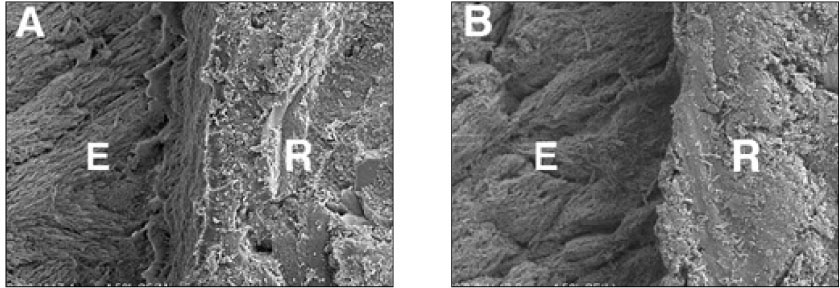References
1. Inoue S, Vargas MA, Abe Y, Yoshida Y, Lambrechts P, Varherle G, Sano H, Van Meerbeek B. Microtensile bond strength of eleven contemporary adhesives to enamel. Am J Dent 2003. 16329–334.
2. Van Meerbeek B, De Munck J, Matter D, Van Landuyt K, Lambrechts P. Microtensile bond strength of an etch & rinse and self-etch adhesive to enamel and dentin as a function of surface treatment. Oper Dent 2003. 28647–660.
3. Van Meerbeek B, Peumans M, Gladys S, Braem M, Lambrechts P, Vanherle G. Three-year clinical effetiveness of four total-etch dentinal adhesive systems in cervical lesions. Quintessence Int 1996. 27775–784.
4. Kanemura N, Sano H, Tagami J. Tensile bond strength to and SEM evaluation of ground and intact enamel surfaces. J Dent 1999. 27523–530.
5. Toledano M, Osorio R, De Leonardi G, Rosales-Leal JI, Ceballos L, Cabrerizo-Vilchez MA. Influence of self-etching primer on the resin adhesion to enamel and dentin. Am J Dent 2001. 14205–210.
6. Kiremitci A, Yalcin F, Gokalp S. Bonding to enamel and dentin using self-etching adhesive systems. Quintessence Int 2004. 35367–370.
7. Vargas M, Cobb D, Denchy G. Interfacial micromorphology and shear bond strength of single-bottle primer/adhesives. Dent Mater 1997. 13316–324.
8. Hipolito VD, de Goes MF, de Oliveira Carriho MR, Chan DCN, Daronch M, Sinhoreti MAC. SEM evaluation of contemporary self-etching primers applied to ground and unground enamel. J Adhes Dent 2005. 7203–211.
9. Shimada Y, Senawongse P, Harnirattisai C, Burrow MF, Nakaoki Y, Tagami J. Bond strength of two adhesive systems to primary and permanent enamel. Oper Dent 2002. 27403–409.
10. Hannig M, Reinhardt KJ, Bott B. Self-etching primer vs phosphoric acid: an alternative concept for composite-to-enamel bonding. Oper Dent 1999. 24172–180.
11. Van Meerbeek B, De Munck J, Inoue S, Yoshida S, Peumans M, Lambrechts P, Vanherle G. Adhesives and cements to promote preservation dentistry. Oper Dent suppl 2001. 6119–144.
12. Daronch M, de Goes FM, Grande RHM, Chan DCN. Antibacterial and conventional self-etching primer system: Morphological evaluation of intact primary enamel. J Clin Pediatr Dent 2003. 27251–256.
13. Nakabayashi N, Pashley DH. Hybridization of dental hard tissue 1998. Tokyo: Quintessense Publishing Co.; 39–44.
14. Yoshida Y, Nagakane K, Fukuda R, Nakayama Y, Okazaki M, Shintani H, Inoue S, Tagawa Y, Suzuki K, De Munck J, Van Meerbeek B. Comparative study on adhesive performance of functional monomers. J Dent Res 2004. 83454–458.
15. Perdigao J, Lopes L, Lambrechts P, Leitao J, Van Meerbeek B. Effects of a self-etching primer on enamel shear bond strengths and SEM morphology. Am J Dent 1997. 10141–146.
16. Toledano M, Osorio R, De Leonardi G, Rosales-Leal JI, Ceballos L, Cabrerizo-Vilchez MA. Influence of self-etching primer on the resin adhesion to enamel and dentin. Am J Dent 2001. 14205–210.
17. Ikeda T, Uno S, Tanaka T, Kawakami S, Komatsu H, Sano H. Relation of enamel prism orientation to microtensile bond strength. Am J Dent 2002. 15109–113.
18. Kerby RE, Knobloch LA, Clelland N, Lilley H, Seghi R. Microtensile bond strengths of one-step and self-etching adheisve systems. Oper Dent 2005. 30195–200.
19. Moura SK, Pelizza A, Bianco KD, de Goes MF, Loguercio AD, Reis A, Grande RH. Does the acidity of self-etching primers affect bond strength and surface morphology of enamel? J Adhes Dent 2006. 875–83.
20. Senawongse P, Sattabanasuk V, Shimada Y, Otsuki M, Tagami J. Bond strength of current adhesive systems on intact and ground enamel. J Esthet Restor Dent 2004. 16107–115.
21. Torii Y, Itou K, Nishitani Y, Ishikawa K, Suzuki K. Effect of phosphoric acid etching to self-etching primer application on adhesion of resin composite to enamel and dentin. Am J Dent 2002. 15305–308.
22. Cehreli SB, Eminkahayagil N. Effect of active pretreatment of self-etching primers on the ultramorphology of intact primary and permanent tooth enamel. J Dent Child (Chic) 2006. 7386–90.
23. Miyazaki M, Hinoura K, Honjo G, Onose H. Effect of self-etching primer application method on enamel bond strength. Am J Dent 2002. 15412–416.
24. Yoshiyama M, Sano H, Ebisu S, Tagami J, Ciucchi B, Carvalho RM, Jonson MH, Pashley DH. Regional strengths of bonding agents to cervical sclerotic root dentin. J Dent Res 1996. 751404–1413.
25. Lopes GC, Marson FC, Vieira LCC, de Andrada MAC, Baratieri LN. Composite bond strength to enamel with self-etching primers. Oper Dent 2004. 29424–429.
26. Finger WJ, Tani C. Effect of application modes on bonding performance of self-etching adhesives. Am J Dent 2005. 1841–44.
27. Yamada T, Sugizaki J. Basic properties and clinical application of the Clearfil SE Bond 2000. In : Processing of the international Kuraray Symposium. Osaka. 1–6.
28. Van Meerbeek B, Vargas M, Inoue S, Yoshida Y, Perdigao J, Lambrechts P, Vanherle G. Microscopy investigations. Techniques, results, limitations. Am J Dent 2000. 133D–18D.
29. Hotta K, Mogi M, Miura F, Nakabayashi N. Effects of 4-MET on bond strength and penetration monomers into enamel. Dent Mater 1992. 8173–175.
30. Yoshida Y, Van Meerbeek B, Nakayama Y, Snauwaert J, Hellemans L, Lambrechts P, Vanherle G, Wakasa K. Evidence of chemical bonding at biomaterial-hard tissue interfaces. J Dent Res 2000. 79709–714.
31. Ferrari M, Mannocci F, Vichi A, Davidson CL. Effect of two etching timers on the sealing ability Clearfil Liner Bond 2 Class V restorations. Am J Dent 1997. 1066–70.
32. Tay FR, Pashley DH. Aggressiveness of contemporary self-etch adhesives. I: Depth of penetration beyond dentin smear layers. Dent Mater 2001. 17296–308.
33. Tay FR, Pashley DH, King NM, Carvalho RM, Tsai J, Lai SCN, Marquezini L. Aggressiveness of self-etch adhesives on unground enamel. Oper Dent 2004. 29309–316.





